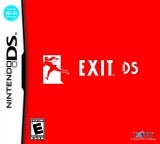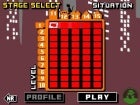Sometimes, you've just gotta get away. Nobody knows that better than Mr. ESC, the star of Taito's interesting action/puzzler, Exit. An escape artist by trade, Mr. ESC is best known not for getting himself into bad situations, but for getting others out of them. Mr. ESC will be applying his unique trade to a whole new market when Exit makes its way to the Nintendo DS next month. So, will gamers be able to escape the addictive nature of Mr. ESC's handheld adventures? Or will the DS version prove inescapable, even for this virtual Houdini?
In case you missed it the first time around, the gist of the game has our intrepid hero charging onto burning, crumbling, and even electrified buildings, tasked with rescuing various people trapped within. Mr. ESC, with a little extra help from his not-so-helpless victims, has to navigate through all manner of obstacles and hazards to get himself and his followers safely to the building's exit. Followers help out by opening certain doors, crawling through smaller spaces, and generally trying to make themselves useful, per the player's commands. If you're a classic game fans, Exit can best be described as the love child of Lemmings and The Lost Vikings.
While earlier iterations of the game on both the PSP and XBLA generally followed basic platformer controls, for the DS version of the game, the developers have created a new control scheme meant to take advantage of both of the DS' screens. The top screen gives players a full map of the current level, complete with icons showing locations of NPCs, hazards, items, and the all-important exit. This map is virtually indispensible when it comes to planning your escape, as it's easy to lose track of Mr. ESC and the other characters among the chaos of navigating through each building.
The bottom screen, where all the action takes place, is what sets this version of Exit apart from all of its predecessors. While other versions of Exit used standard platformer controls to add more action to the experience, the DS version focuses more on the puzzle aspect thanks to the touch screen controls. In order to navigate through the level, the player first taps on Mr. ESC (or one of his helpers), and then taps somewhere else on the screen to move, to push boxes, to climb ropes and ladders, to pick up items, or to rescue victims. By holding down the left shoulder button, players can link up to nine moves together. In fact, some of the early stages can be completed in one fell swoop, planning all of Mr. ESC's moves right from the start. In some ways, this helps speed things up, as players can set up a chain of events in one part of the building while executing a series of moves with a different character in another part of the building. Be forewarned, though. Effectively making the most of the controls looks like it'll take a lot of patience. Sometimes, it just seems like it's too much to keep track of at once.
Visually, Exit looks phenomenal on the DS. The levels are filled with color and, despite the game's seemingly simplistic animated style, there's a certain sort of elegance to it all. Adding to the visual appeal, all of Exit's in-game animations are smooth and fluid. Games like this and N+ that show you don't need high-definition graphics to put together an aesthetically pleasing presentation.
I'd like to have seen some sort of downloadable content to extend the replayability, as players saw in the PSP version. Even the XBLA version had a total of over 200 levels to play through. Instead, the only online option available on the DS is a leaderboard for players to compare their best times to others around the world. Even without it though, Exit still packs in enough content to justify its planned $20 price.
So far, Exit is shaping up to be a pretty solid entry to the DS puzzle library. While it doesn't have falling blocks, rotating jewels, or any of the other usual suspects in puzzle games, Mr. ESC's escapades should be up to the task of challenging DS owners' brains.





